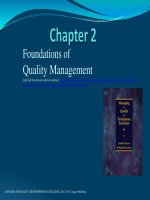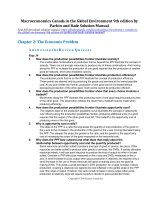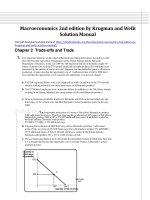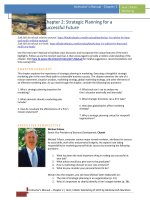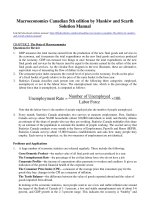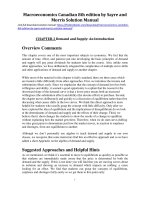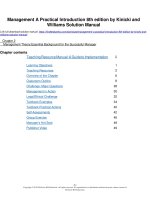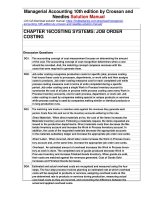Marine biology 10th edition by castro and huber solution manual
Bạn đang xem bản rút gọn của tài liệu. Xem và tải ngay bản đầy đủ của tài liệu tại đây (205.01 KB, 3 trang )
Chapter 02 - The Sea Floor
Marine Biology 10th edition by Peter Castro and Michael E.
Huber Ph.D. Solution Manual
Link full download solution manual: />Link full download test bank: />CHAPTER 2: THE SEA FLOOR
Chapter Outline
2.1 The Water Planet
The Geography of the Ocean Basins
The Structure of the Earth
Internal Structure
Continental and Oceanic Crusts
2.2 The Origin and Structure of the Ocean Basins
Early Evidence of Continental Drift
The Theory of Plate Tectonics
Discovery of the Mid-Ocean Ridge
Significance of the Mid-Ocean Ridge
Creation of the Sea Floor
Sea-Floor Spreading and Plate Tectonics
The Geologic History of the Earth
Continental Drift and the Changing Oceans
The Record in the Sediments
Climate and Changes in Sea Level
2.3 The Geological Provinces of the Ocean
Continental Margins
The Continental Shelf
The Continental Slope
The Continental Rise
Active and Passive Margins
Deep-Ocean Basins
2.4The Mid-Ocean Ridge and Hydrothermal Vents
Box Readings:
2.1 Eye on Science: Life Below the Sea Floor
2.2 The Hawaiian Islands, Hot Spots, and the Great Mantle Plume Debate
Chapter Summary
Chapter 2 summarizes the basic aspects of the geology of the sea floor and points out its relevance to marine
biology. It includes numerous up-to-date maps and illustrations that are especially designed to serve as
teaching aids.
The basic structural features of the ocean basins and the Earth are briefly described first. This material introduces the
student to a more detailed discussion of the origin of the ocean basins and the theory of plate tectonics. Information
is organized in an easy-to-follow progression: early evidence for continental drift, the discovery and significance of
the mid-ocean ridges, the creation of the sea floor, for a complete portrait of plate tectonics—the mechanisms that
explain it all. Plate tectonics is then used to explain features such as trenches, island arcs, and faults. The box
reading on the origin of the Hawaiian Islands further illustrates the consequences of plate tectonics.
2-1
Copyright © 2016 McGraw-Hill Education. This is proprietary material solely for authorized instructor use. Not authorized for
sale or distribution in any manner. This document may not be copied, scanned, duplicated, forwarded, distributed, or posted on
a website, in whole or part.
Chapter 02 - The Sea Floor
The discussion of plate tectonics is followed by a description of the geologic history of the earth. It covers material
that is relevant to current concerns about climate change. Integrated into this discussion is an introduction to the
importance of marine sediments in providing evidence of past oceanic conditions. The chapter concludes with an
outline of the geologic provinces of the ocean, which includes an explanation of the continental shelf, continental
slope, continental rise, active and passive continental margins, and deep-ocean basins. This section highlights
hydrothermal vents, the deep-sea hot springs that serve as home to a most fascinating type of marine life.
The relationships between the material covered in Chapter 2 and the discussion of various aspects of life in the sea
is reviewed and further integrated throughout the book by means of marginal review notes.
Student Learning Outcomes
1. Demonstrate an understanding of the basic structure of the earth.
2. Describe the evidence to support that plate tectonics is responsible for the origin and structure of the ocean basins.
3. Diagram the geological provinces of the ocean.
4. Contrast active and passive continental margins.
Answers to Critical Thinking Questions
1. Plate tectonics works today in the same way as in the past. Can you project future positions of the continents by
looking at a map of their present positions and the positions of the mid-ocean ridges (see Fig. 2.5)? What oceans
are growing and which are shrinking? Where will new oceans form?
North and South America will be farther west toward the Pacific, Europe and Asia farther southeast, Australia
farther northeast, and Africa farther east. The Pacific is therefore expected to be narrower and the Atlantic
wider. The map in Fig. 2.9 actually indicates the direction of plate movement but it’s better if students deduce
these movements by the location of the mid-ocean ridges as indicated on the map in Fig. 2.5.
2. Why are most oceanic trenches found in the Pacific Ocean?
Due to the collision of a continental plate and an oceanic plate or two oceanic plates in the Pacific Ocean, one plate
is forced below the other. At these collision sites, trenches form. Volcanoes and earthquakes are also associated with
these sites.
3. Scientists who study forms of marine life that lived more than 200 million years ago usually have to obtain fossils
not from the sea floor, but from areas that were once undersea and have been uplifted onto the continents. Why?
Due to changing sea-level over geologic history, these fossils are now located above sea level.
4. What are some of the major pieces of evidence for the theory of plate tectonics? How does the theory
explain these observations?
Scientist Alfred Wegner was the first to propose that the continents we know today were once joined into a single
supercontinent he called Pangaea. He noted that the edges of the continents fit together much like puzzle pieces.
Since he could not explain how these continents traveled away from one another to their current positions, his
work was not supported at that time. Since that time, however, evidence to support his theory has continued to
accumulate.
One of the major pieces of evidence for his theory is the discovery of mid-ocean ridge system in the ocean basins.
These ridges are a continuous chain of submarine volcanoes and geologic activity is concentrated around these
areas. At these ridges, oceanic crust is separating as molten rock flows from the Earth’s interior. New rock is formed
in this way and older rock is pushed further from the ridges. Sediments are deeper on ocean floor located away from
the ridge, demonstrating that this area has had more time to accumulate these sediments. Rocks are also known to be
older moving away from the ridges.
Perhaps the strongest piece of evidence to support the activities at the mid-ocean ridges is the discovery of bands, or
stripes, on sea-floor rocks known as magnetic anomalies. These anomalies occur because as molten rock cools,
2-2
Copyright © 2016 McGraw-Hill Education. This is proprietary material solely for authorized instructor use. Not authorized for
sale or distribution in any manner. This document may not be copied, scanned, duplicated, forwarded, distributed, or posted on
a website, in whole or part.
Chapter 02 - The Sea Floor
magnetic particles in the rocks point towards a magnetic point on the Earth. At different times during geologic
history, this magnetic point is magnetic north as it is today. At other times, the field has reversed to create a
magnetic south instead. These magnetic anomalies show the direction of this magnetic field at the time they were
formed. Therefore, these bands show that the sea floor was not formed all at once, but in stages over geologic time.
As new sea floor is created, sea floor in other areas is destroyed as some plates are forced together by this
movement. In these areas, trenches are formed. Evidence includes: the fitting together of the coasts of the continents
on the opposite sides of the Atlantic Ocean, the similarity of geologic formations and fossils found on the opposite
sides, a geologically active mid-ocean ridge running along the central Atlantic between the opposite coasts, bottom
sediments that get thicker the farther one travels from the ridge, and rocks on the sea floor on one side of the ridge
show magnetic bands that are mirror images of rocks found on the opposite side of the ridge. All of these
observations are explained by sea-floor spreading from the mid-ocean ridge.
2-3
Copyright © 2016 McGraw-Hill Education. This is proprietary material solely for authorized instructor use. Not authorized for
sale or distribution in any manner. This document may not be copied, scanned, duplicated, forwarded, distributed, or posted on
a website, in whole or part.
